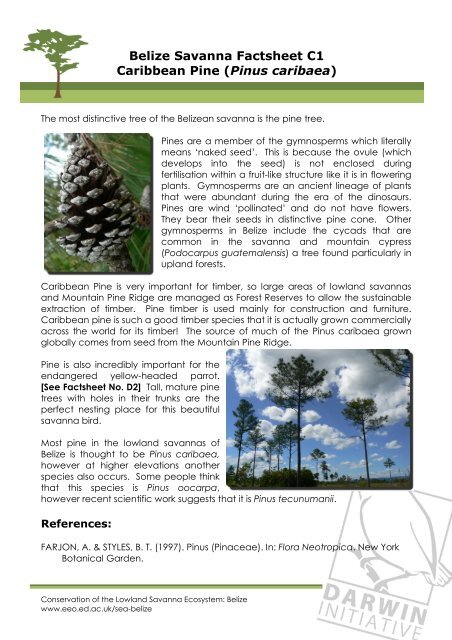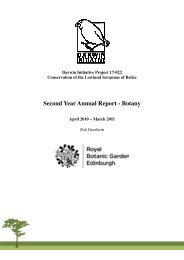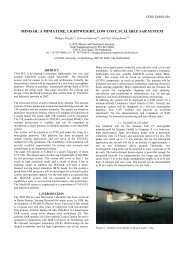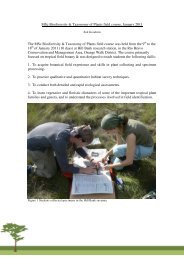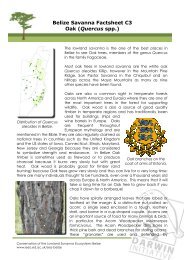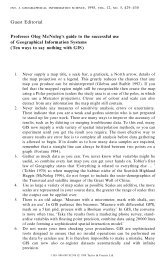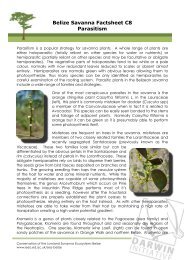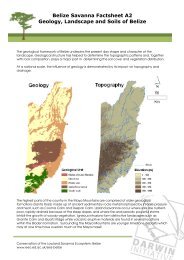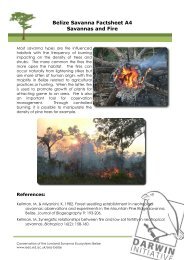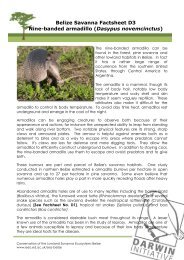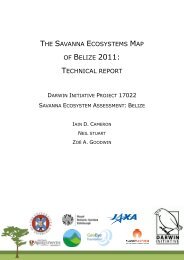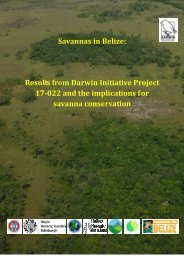Belize Savanna Factsheet C1 Caribbean Pine (Pinus caribaea)
Belize Savanna Factsheet C1 Caribbean Pine (Pinus caribaea)
Belize Savanna Factsheet C1 Caribbean Pine (Pinus caribaea)
You also want an ePaper? Increase the reach of your titles
YUMPU automatically turns print PDFs into web optimized ePapers that Google loves.
<strong>Belize</strong> <strong>Savanna</strong> <strong>Factsheet</strong> <strong>C1</strong><strong>Caribbean</strong> <strong>Pine</strong> (<strong>Pinus</strong> <strong>caribaea</strong>)The most distinctive tree of the <strong>Belize</strong>an savanna is the pine tree.<strong>Pine</strong>s are a member of the gymnosperms which literallymeans ‘naked seed’. This is because the ovule (whichdevelops into the seed) is not enclosed duringfertilisation within a fruit-like structure like it is in floweringplants. Gymnosperms are an ancient lineage of plantsthat were abundant during the era of the dinosaurs.<strong>Pine</strong>s are wind ‘pollinated’ and do not have flowers.They bear their seeds in distinctive pine cone. Othergymnosperms in <strong>Belize</strong> include the cycads that arecommon in the savanna and mountain cypress(Podocarpus guatemalensis) a tree found particularly inupland forests.<strong>Caribbean</strong> <strong>Pine</strong> is very important for timber, so large areas of lowland savannasand Mountain <strong>Pine</strong> Ridge are managed as Forest Reserves to allow the sustainableextraction of timber. <strong>Pine</strong> timber is used mainly for construction and furniture.<strong>Caribbean</strong> pine is such a good timber species that it is actually grown commerciallyacross the world for its timber! The source of much of the <strong>Pinus</strong> <strong>caribaea</strong> grownglobally comes from seed from the Mountain <strong>Pine</strong> Ridge.<strong>Pine</strong> is also incredibly important for theendangered yellow-headed parrot.[See <strong>Factsheet</strong> No. D2] Tall, mature pinetrees with holes in their trunks are theperfect nesting place for this beautifulsavanna bird.Most pine in the lowland savannas of<strong>Belize</strong> is thought to be <strong>Pinus</strong> <strong>caribaea</strong>,however at higher elevations anotherspecies also occurs. Some people thinkthat this species is <strong>Pinus</strong> oocarpa,however recent scientific work suggests that it is <strong>Pinus</strong> tecunumanii.References:FARJON, A. & STYLES, B. T. (1997). <strong>Pinus</strong> (Pinaceae). In: Flora Neotropica. New YorkBotanical Garden.Conservation of the Lowland <strong>Savanna</strong> Ecosystem: <strong>Belize</strong>www.eeo.ed.ac.uk/sea-belize
HICKS, J., et al. (In Press). A Floristic Description of the San Pastor <strong>Savanna</strong> andPreliminary Checklist of the <strong>Savanna</strong>s of <strong>Belize</strong>, Central America. EdinburghJournal of Botany.Conservation of the Lowland <strong>Savanna</strong> Ecosystem: <strong>Belize</strong>www.eeo.ed.ac.uk/sea-belize


